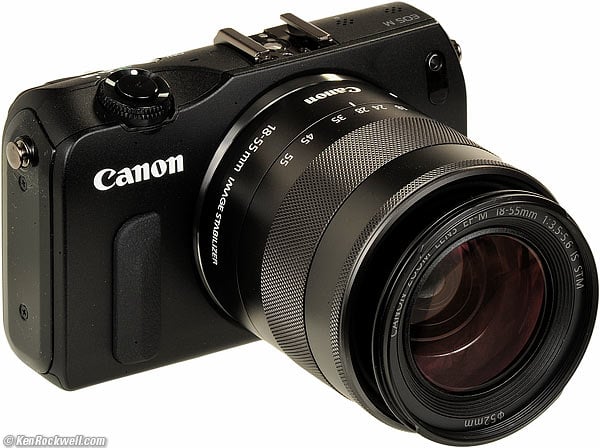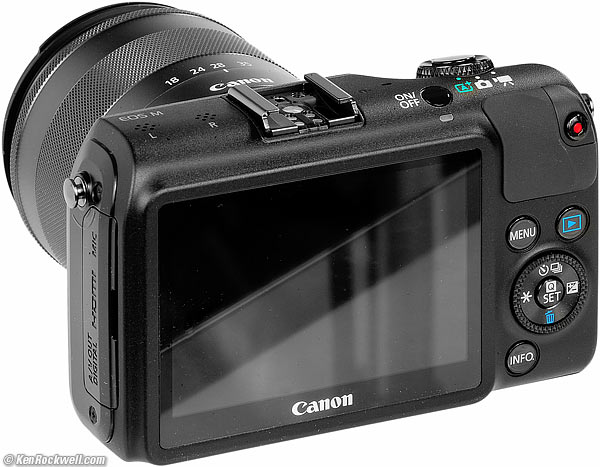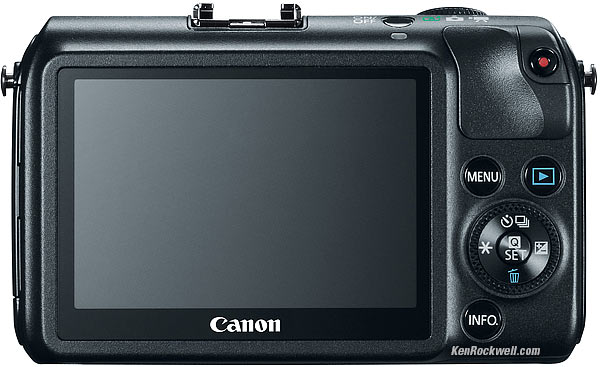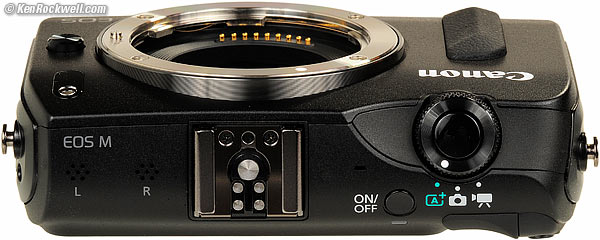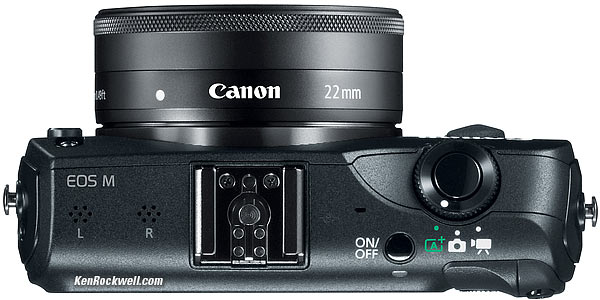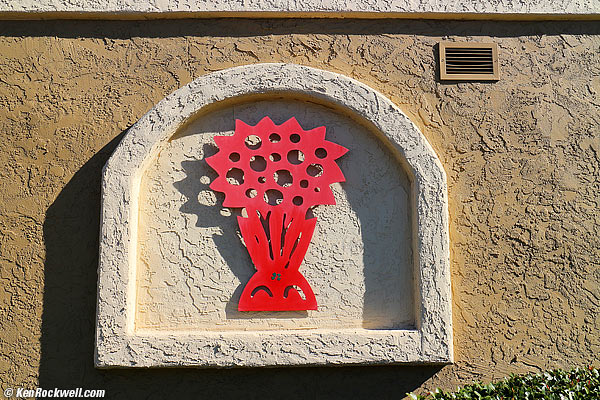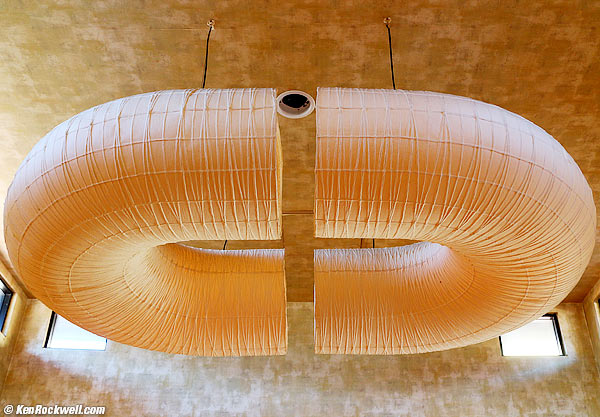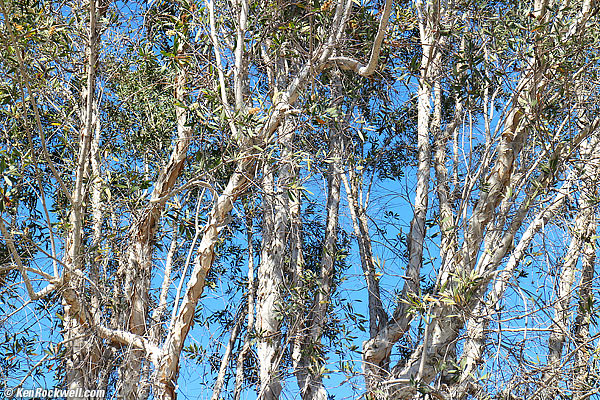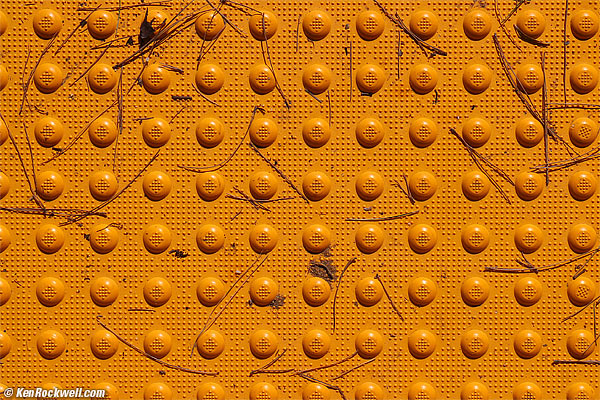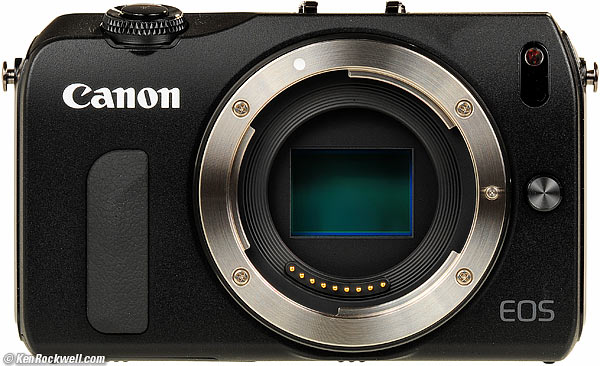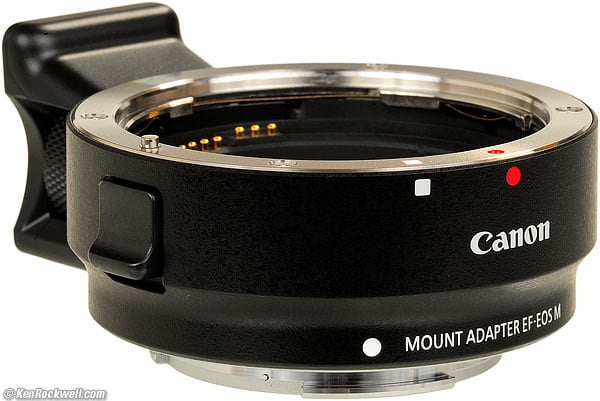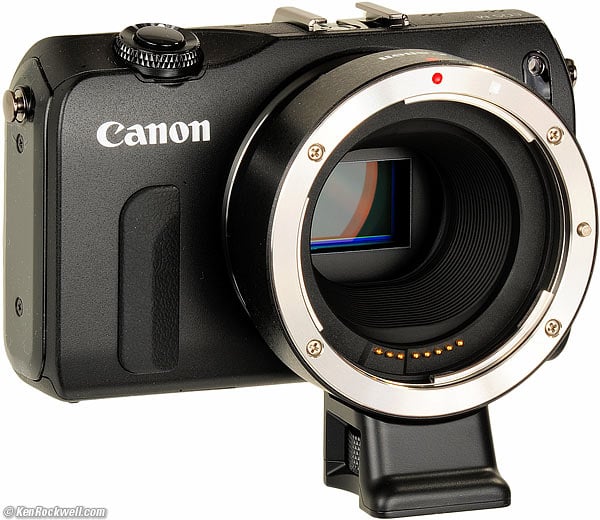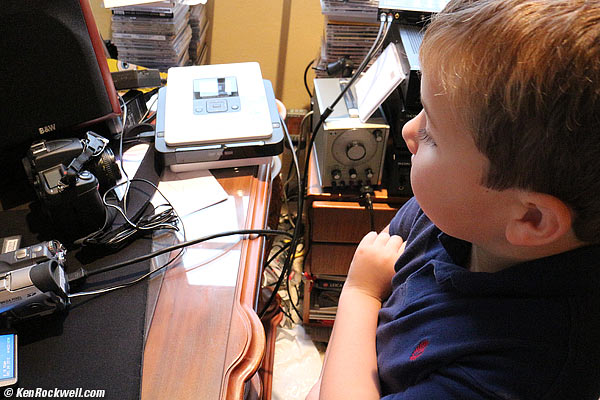Home Donate New Search Gallery Reviews How-To Books Links Workshops About Contact
Canon EOS M
1.6x, 18 MP Mirrorless
The world's first serious mirrorless camera.
© 2013 KenRockwell.com. All rights reserved.
Intro Lenses Specs Performance Compared Recommendations More
Canon EOS M with EF-M 18-55mm IS STM. (10.4 oz./295g, 1.6x sensor, takes EF-M lenses, EF and EF-S lenses with adapter, about $800 with 22mm lens or $850 with 18-55mm lens as shown). enlarge. My biggest source of support is when you use any of these links, especially this link directly to it at Adorama or directly to it at Amazon, when you get anything, regardless of the country in which you live. Thank you! Ken.
Rear, Canon EOS M with EF-M 18-55mm IS STM. enlarge.
Back, Canon EOS M. enlarge.
Top, Canon EOS M. enlarge.
Top, Canon EOS M and 22mm f/2 STM. enlarge.
January 2013 Canon Reviews EOS-M Review EOS-M System All Reviews
NEW: Canon EOS M3.
Sample Image Files
Palm. Canon EOS-M, 18-55mm IS at 18mm, f/6.3 at 1/125, STANDARD Picture Style with 6 sharpening and +3 Saturation. Camera-Original © 7 MB LARGE JPG File.
Century Plant . Canon EOS-M, 18-55mm IS at 18mm, f/7.1 at 1/160, STANDARD Picture Style with 6 sharpening and +3 Saturation. Camera-Original © 4 MB LARGE JPG File.
Red Plant. Canon EOS-M, 18-55mm IS at 24mm, f/10 at 1/200, STANDARD Picture Style with 6 sharpening and +3 Saturation. Camera-Original © 7 MB LARGE JPG File.
Split Torus. Canon EOS-M, 18-55mm IS at 24mm, f/4 at 1/30, STANDARD Picture Style with 6 sharpening and +3 Saturation. Camera-Original © 3 MB LARGE JPG File.
Eucalyptus. Canon EOS-M, 18-55mm IS at 39mm, f/8 at 1/125, STANDARD Picture Style with 6 sharpening and +3 Saturation. Camera-Original © 9 MB LARGE JPG File.
Yellow. Canon EOS-M, 18-55mm IS at 42mm, f/11 at 1/320, STANDARD Picture Style with 6 sharpening and +3 Saturation. Camera-Original © 9 MB LARGE JPG File.
Introduction top
Intro Lenses Specs Performance Compared Recommendations More
The Canon EOS-M is an extremely well made and tiny camera with technical image quality identical to Canon's 1.6x DSLRs. In fact, it might be a tad better in actual use because its dedicated EF-M 18-55mm IS STM and EF-M 22mm f/2 STM lenses are better than the similar EF-S lenses offered for DSLRs. The EOS-M can be used to create extraordinary images, and for me, its color rendition for photos of things is far superior to anything from LEICA, Fuji or Sony.
The EOS-M is a great camera for travel and landscape shots where the subjects hold still. Image quality is wonderful. It's got a magnesium and stainless steel frame and its controls are mostly machined out of metal.
The bad news is that the EOS-M is slow. It's too slow to be useful for people, action, sports, kids or most family photos. It seems slower than most Canon Powershot cameras since its autofocus system seems slower because the lenses of the EOS-M need to move much further to focus due to the much larger sensor.
Autofocus is slow, and worse, the camera itself is slow. The EOS-M seems to have no shooting buffer, meaning that after every shot you'll often see a big BUSY flash on the screen and the entire camera locks-up for a second or more while it takes its time writing the last image to your card. Who's in charge here: am I here to serve and wait around for my camera? In any case, it can't shoot quickly from shot-to-shot, unlike a real DSLR.
Autofocus is laughably slow. It takes a moment, and it often has to hunt (oscillate back and fourth a few times) before it locks-on. How slow is it? As a reality check, I pulled out my original Canon EOS 650 (Canon's very first 35mm EOS camera from 1987) and a 1980s Canon EF 50mm f/1.8 lens, and the 26-year old SLR focuses much faster! The EOS-M is as pokey as any other DSLR in its Live View mode, which essentially is the EOS-M: a 1.6x DSLR minus the mirror, prism and live (not via image-sensor) autofocus system. Real SLRs and DSLRs focus much, much faster when used in their normal (not live view) modes. Ignore Canon's claims of phase-detection sensors on the EOS-M; whatever's going on, it's slower and more clueless than my 26-year-old EOS 650 35mm camera.
The EOS-M has a different user interface from Canon's DSLRs. It takes bits of the usual EOS SLR operating system and a touch-screen operating system, and therefore handles differently than DSLRs, making it a confusing choice as an accessory camera if you use Canon DSLRs every day as I do.
The EOS-M has so many ridiculous touch screen displays that it makes me feel stupid. I won't accept a camera that makes me feel stupid when there are better choices for tiny cameras that just go — like my iPhone 5. Part of the problem is that the EOS-M lacks enough real controls on its body, and instead relegates them to the touch screen. There are so many different displays that come up for different things that they make no sense; you'd have to use the EOS-M as your only camera for a while to hope that whatever it's doing would start to become familiar.
The touch screen is swell, but there is still a slight delay in response to all inputs, which for a picky guy like me that demands instant response, isn't good. It's difficult to get the EOS-M to do what I need it to do; the touch-screen system is balky. Maybe it just needs a bigger screen — like my iPhone 5.
This review will go on and on, but you already have 95% of what there is to say. The EOS-M is a jewel for photos of things that hold still and mostly likely a queen in the lab where nothing changes, but a nightmare for use in the field, outdoors, or if anything is moving.
But wait, there's more! The EOS-M has no viewfinder. You have to hold it at arm's length and stare at its LCD to compose, and the LCD lacks auto brightness control so it's nowhere near as visible in different light as the auto-brightness-controlled screens of an iPhone 5 or a 5D Mark III, either of which are far more visible in daylight. Oh yes - my iPhone 5 handles much faster and focuses much faster than the EOS-M, too!
The EOS-M has no built-in flash, so Canon wants you to buy the new Speedlite 90EX, which isn't very good either.
There is no sleep mode. Unlike a DSLR, LEICA M9 or Fuji that goes to sleep, and then wakes up simply by tapping its shutter button, the EOS-M simply turns off for good after a few minutes of inactivity. Just like a Powershot, you have to turn it on again each time. Startup time is rated as 1.6 seconds (1,600 milliseconds).
The strap attachments are weird little mushroom-shaped things, so none of my favorite straps will work.
The EOS-M, like most mirrorless cameras, is a battery hog. Expect only about 200 shots per charge, as opposed to about 1,000 shots per charge with a DSLR. This is because the LCD and all the electronics are always on, even if you're only trying to compose the shot.
A Canon Rebel T3i has the same technical image quality as the EOS-M, but handles and focuses much better and faster — and it costs less. The T3i's battery is rated for 2.5 times as many shots per charge. The only reason for the EOS-M is that its body is smaller than a DSLR, but considering what a pain it is to shoot with the EOS-M, I'd much rather carry a small DSLR like the T3i than dick around with the EOS-M.
Intro Lenses Specs Performance Compared Recommendations More
Canon EOS M and EF-M mount (smaller than EF mount). enlarge.
The Canon EOS-M only works with a new kind of smaller-mount EF-M lenses.
With a new adapter, the EOS-M also takes all our EF and EF-S lenses, with everything like autofocus and image stabilization working perfectly.
Canon Mount Adapter EF-EOS M on an EOS-M. Note larger EF mount.
Want a great ultrawide? Your existing EF-S 10-22mm works great when you use the adapter, and so do all of your teles, fast primes, macros and other Canon lenses. You don't have to go buying more lenses; if you shoot Canon, you probably already have exactly what you need.
Just as EF-S lenses only work on small DSLRs or this EOS-M with adapter, these newest EF-M lenses are an even more restricted subset that only work on the EOS M. There are no adapters to use EF-M lenses on DSLRs or 35mm cameras. This is because 1.) EF-M lenses only cover small sensors, not 35mm or full-frame, and 2.) they have a very short back focus to work on the shallow EOS M which has very little depth from mount to sensor.
35mm and DSLR cameras are much deeper from mount to sensor, so one couldn't possibly get EF-M lenses close enough to a DSLR's sensor to focus at anything other than super-macro distances. You'd have to hack away a half-inch of lens or camera to get the combination of EF-M lens and SLR to focus properly.
Lens Compatibility Table
EF (1987-) |
Yes |
Yes |
Yes |
Yes |
|
EF-S (2004-) |
no |
no |
no |
Yes |
|
EF-M (2012-) |
no |
no |
no |
no |
Yes |
© 2013 KenRockwell.com.
Focus Pocus
EF and/or STM lenses all autofocus on all cameras to which they mount.
STM is supposedly a quieter sort of motor, but otherwise, focus compatibility is the same as with any other Canon autofocus (EF) lens. This means you have to look to see if it's EF, EF-S or EF-M to see on what cameras it works. STM does not mean it works directly on the EOS M!
The EF 40mm f/2.8 is compatible with everything because it's EF. You still need the adapter to mount it on the EOS-M.
The EF-S 18-135mm IS STM works on everything except full-frame and 35mm because it's EF-S. You still need the adapter to mount it on the EOS-M.
The EF-M 22mm f/2 and EF-M 18-55mm f/3.5-5.6 IS STM only work on the EOS M because they are EF-M. Being native EF-M they pop right on the EOS M, and won't ever work on any SLR.
Einsatz mit Leica M?
Sorry, Canon got us all excited by using the model number reserved for their full-frame LEICA M-mount camera for this unrelated camera — although Canon, founded in 1933 for the sole purpose of making cheap copies of the new 35mm LEICA, copies LEICA's original diamond knurling on the lenses shown below! Old rivalries never die.
The EF-M mount is not a LEICA mount. There certainly will be LEICA M adapters, but please do not soil LEICA M lenses by wasting them on a half-frame camera. LEICA lenses deserve full-frame cameras only.
If Canon ever creates a full-frame LEICA M body, either in 35mm or digital, it would half-bury LEICA, so I suspect that Canon hasn't done this simply to keep LEICA in business our of respect for elders.
Specifications top
Intro Lenses Specs Performance Compared Recommendations More
Sensor
18.0-megapixel CMOS, about 22.2 x 14.8 mm (almost APS-C).
ISO 100-12,800 (expandable to 25,600 in H mode).
Video: ISO 100-6,400 (expandable to 12,800 in H mode).
Shutter
Focal-plane shutter.
Maximum speed with flash (sync): 1/200.
Autofocus
It uses a Hybrid CMOS AF system for continuous autofocus and tracking of moving subjects, claimed even with movies. The Hybrid CMOS AF system is located on the CMOS sensor itself and combines phase-difference AF and contrast AF.
The Movie Servo AF function on the EOS M is enabled by default which keeps images on the rear screen in constant focus, even before the shutter is pressed. This continual focus makes for sharp video capture and help reduce shutter lag — but it also sucks down batteries.
It has three AF schemes for video and photos: Face Detection & Tracking AF, Multi-Point AF for automatic selection and Single-Point AF, with your choice of 31 AF points.
With STM lenses like the EF-M 22mm f/2 STM, or EF-M 18-55mm f/3.5-5.6 IS STM, EF-S 18-135mm IS STM or 40mm f/2.8 lenses, the AF system remains silent while focusing for movies.
There's an AF assist LED.
Video
Movie Servo AF for continuous focus tracking of moving subjects.
Manual and auto exposure control.
Built-in S-t-e-r-e-O microphone with a wind filter and an attenuator.
Manual and auto audio level control with 64 levels.
Video Snapshot mode with touch-screen editing.
Video format: MPEG-4 AVC H.264.
File format: .MOV.
NTSC and PAL professional frame rates:
1080 at 29.97p, 23.976p and 25p.
720 at 59.94p or 50p.
640 x 480 at 29.97p or 25p.
Video uses Picture Style settings - including custom Picture Styles.
LCD
3" Touch Screen.
1,040,000 dots.
Smudge-resistant coating.
Multi-touch operation: "pinch-to-zoom" and "swiping" to scroll between pictures.
Touch AF to select AF area.
Flash
No built-in flash.
Hot shoe.
E-TTL II flash metering (evaluative flash metering and average flash metering).
FE Lock.
Flash Exposure Compensation: ±2 stops in 1/3-stop or 1/2-stop increments.
No PC sync terminal; use a hot-shoe adapter.
Compatible with all Canon Speedlite accessories including the new Speedlite 600EX and Speedlite Transmitter ST-E3-RT.
Memory
SD, SDHC, SDXC and UHS-I cards.
GPS
None thank goodness, but compatible with Canon's external GPS Receiver GP-E2 ($270).
Size
4.28 x 2.62 x 1.27 inches.
108.6 x 66.5 x 32.3 millimeters.
Weight
10.415 oz. (295.3g), measured with battery and card.
Canon rates it at 10.5 oz. (298g) with battery and card.
Canon rates it at 9.2 oz. (262g), stripped.
Power
Canon LP-E12 battery pack for EOS M.
Rated only about 230 shots or 90 minutes of video per charge.
Optional AC Adapter Kit ACK-E12.
Included
CANON EOS M Digital Camera Body.
Body cap.
(possibly a lens and lens caps as a kit.)
Neck Strap EM-100DB.
Battery Charger LC-E12.
Battery Pack LP-E12.
Battery Cover.
EOS Digital Solution Disk.
Kit Warranty Card.
Announced
12:08 AM, Monday, 22 July, 2012.
Promised
October 2012.
Shipping
Late 2012.
Quality
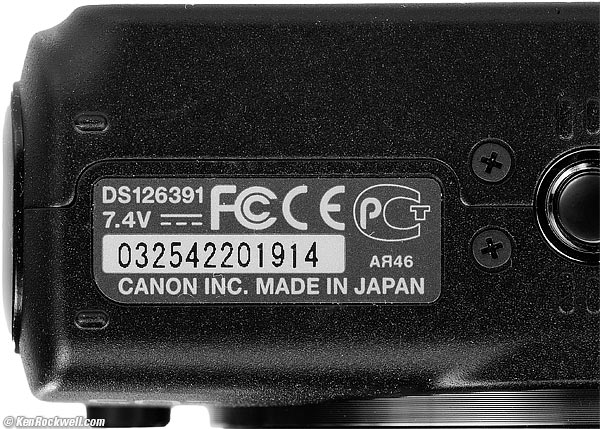
Bottom, Canon EOS M.
Camera made in Japan, but everything else like the 18-55 and 22/2 lenses are made in Taiwan.
Prices & Accessories, USA
Late 2012-Jan 2013:
EOS M and 22mm f/2 STM Lens: $800.
EOS M and 18-55mm STM Lens: $850.
22/2 lens alone: $250.
EF-M 18-55mm f/3.5-5.6 IS STM lens alone: $300.
EF 40mm f/2.8 STM: $200 (needs Mount Adapter EF-EOS M: $200).
Speedlite 90EX: $150.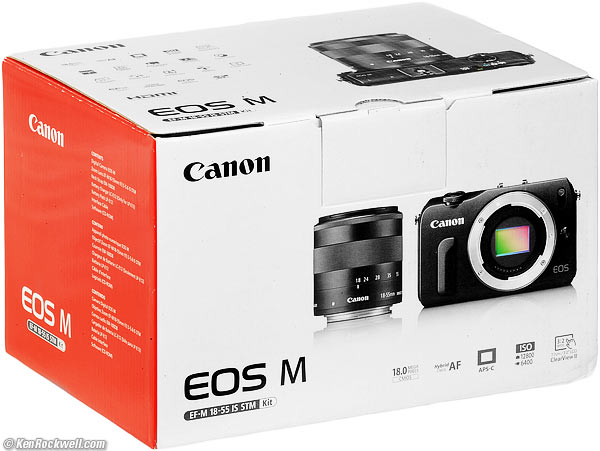
Box, Canon EOS M with EF-M 18-55mm IS STM.
Performance top
Intro Lenses Specs Performance Compared Recommendations More
Overall
I covered most of Performance at the Introduction above. Below are merely more details.
Autofocus
It's slow.
It tends to focus where it wants to, like on the dirt on a glass window instead of the subject behind the window. It's easy to tap the screen to tell it where in the frame to focus, but difficult to tell it where in distance to focus, like behind an obstruction.
I presume there is a manual focus mode, but I never found it or got manual focus override to work.
Exposure
Exposure is fine.
If setting an aperture value in Av mode, it only recognizes and lets you set the range of apertures available when you called up the setting screen. If you zoom the lens and want another aperture now available at the new zoom setting, you have to exit the INFO screen and go back in so it recognizes the new range available.
Flash Exposure
Flash exposure is usually OK, but it will overexpose at a couple of feet and closer. It did this with both the 90EX and 220EX: at a few feet, I had to dial-in a couple of stops of negative exposure compensation.
Technical Image Quality
As above, it's the same as Canon's 1.6x DSLRs — it's got the same sensor and processors behind it. This means awesome colors right out of the camera!
High ISOs
Ryan is not that impressed with the clutter in Dada's laboratory. (Canon EOS-M, Canon EF-M 18-55mm IS STM at 18mm, Auto ISO 5,000, f/8 at 1/40, Athentech Perfectly Clear plug-in in Photoshop CS6.) original file.
High ISO performance is the same as other cameras with this size sensor. Around ISO 6,400, you'll see some noise, but it's not annoying — but still nowhere near as clean as full-frame. No news here.
Ergonomics
There is too much menu diddling to set what I need. There are too few real knobs and buttons to get the job done. Instead, you have to stop paying attention to your subject and do a Vulcan mind-meld with two hands and the camera, meaning you're not concentrating on your picture. Any DSLR is much better.
I never found any "C" recall modes, which are critical for recalling all my settings immediately.
I detected a tiny bit of shutter delay even after locked-on, unlike DSLRs that just go instantly.
The EOS-M feels like a quality product, feeling like it's all metal.
Auto ISO
Auto ISO only lets one select the highest ISO to which the camera will set itself. I never found any way to set the slowest shutter speed.
Sounds and Noise
The focal plane shutter is smooth and not very loud, but far from silent like the leaf shutter of the Fuji X100.
Everyone will hear the EOS-M if trying to shoot in a quiet setting.
LCD
The LCD is sharp and color-accurate.
There's no auto brightness control, so it's usually too dim outdoors.
The refresh (frame) rate doesn't increase when you've pressed the shutter halfway, so the LCD image as you're trying to shoot is still a little jumpy and delayed as you're about to fire.
Playback
The touch screen works: to zoom, use two fingers.
As always with Canon, it's slow to read all the data and draw the image at full resolution as you swap among images.
You can swap images while zoomed: just turn the control wheel.
The curse of Canon, I never figured out how to zoom an image displayed right after it was shot. I had to hit PLAY again.
Battery Life
I got the first indication that the battery was wearing down after 130 shots.
200 shots per charge seems about right.
Compared top
Intro Lenses Specs Performance Compared Recommendations More
The Canon EOS M is the world's first serious mirrorless camera that actually gives good images, and by good images, I mean images with fantastic color as shot. Other brands like Sony, Fuji and LEICA don't give me the colors I demand unless I fiddle with them afterwards, and doing this for a living, I can't afford to fix something afterwards that shouldn't have been broken in the first place. I love the colors I get from Canon right out of the camera as JPGs.
By "mirrorless" I mean modern digital cameras with DSLR image quality, live through-the-lens (TTL) viewing and interchangeable lenses, just without the flipping mirror. Obviously 4x5" cameras have no mirrors, but I'm not referring to them.
By "serious," I mean professional grade. Sony, Samsung, Fuji, Olympus, Panasonic and other third-tier brands offer lots of mirrorless cameras, but then aren't pro grade; they are just consumer electronics products and usually only with smaller 4/3 sensors (or smaller) and/or lens mounts often with few advanced lenses available. (First tier is LEICA, classic Hasselblad, Contax and others. Second tier is Nikon and Canon. Third tier is Panasonic, Samsung, Fuji, Olympus etc., and fourth tier is Vivitar, Sunpak, Coby and so forth.)
While a serious camera with a big sensor and no mirror; the LEICA M9 doesn't count: it has no TTL viewing, so you never really know what's in your picture until after it's taken!
The Fuji X-Pro1 is the next best thing to the EOS M, but again limited by too few lenses and a weird custom mount and only so-so color rendition. It's a great start, but lacks Canon's color savvy and system breadth. The limited lens selection is OK since it has everything I need, but the sloppy colors are almost as bad as the LEICA M9's
Up until now, there have been no serious professional mirrorless camera systems.
Compared to the solid mostly metal EOS-M, the Sony NEX-5R feels like a toy.
The Nikon 1
The Nikon 1 is a toy with a tiny 8.8 x 13.3mm (2.7x) sensor only half the area of 110 film, and only about one-third the area of the 22.2 x 14.8 mm (1.6x) sensor of the EOS M.
The Nikon 1 offers an F-Mount adapter, but it is only partially compatible with AF-S lenses and won't autofocus at all with traditional Nikon AF lenses.
Even if you could use all of your Nikon lenses on it, because of the tiny sensor of the Nikon 1 system, there are no very wide angle lenses available. The widest lens available is equivalent only to 28mm on full-frame. Pull out an unobtainable 13mm f/5.6 NIKKOR ultra-ultrawide (118º undistorted on FX), and you get only the equivalent of a 35mm lens on the Nikon 1!
Contrast this all to the EOS M, with which your existing EF-S 10-22mm works great when you use the adapter and covers the equivalent of a 16-35mm lens, and so do all of your teles, fast primes, macros and other Canon lenses.
You don't have to go buying more lenses with the EOS M; if you shoot Canon, you probably already have exactly what you need. The EOS M is part of your pro system already.
Recommendations top
Intro Lenses Specs Performance Compared Recommendations More
The EOS M delivers high-quality images in a tiny, high quality package — but it's slow.
The cheapest DSLR like a Rebel T3i performs as well or better for a lot less money, and includes a great flash and viewfinder, but it's a little bigger. Personally, I don't find the small extra size of the T3i annoying, but the slowness and quirks of the EOS-M drive me up a wall. My money's on a small Canon DSLR and not this EOS M.
The Rebel isn't that much bigger, and you can put the same EF 40mm f/2.8 STM lens on the Rebel directly without an adapter to make it small, and the Rebel includes a flash and finder!
So, just like the Canon G1 X, in the EOS-M we have a luxury camera for those who value small size but not speed. The EOS-M isn't small once you put large lenses or adapters on it; be careful.
If you've found all the time, effort and expense I put into researching and sharing all this, this free website's biggest source of support is when you use any of these links, especially this link directly to it at Adorama or directly to it at Amazon, when you get anything, regardless of the country in which you live.
Thank you!
Ken.
More Information top
Intro Lenses Specs Performance Compared Recommendations More
Canon USA's long instruction manual.
Canon USA's sane instruction manual.
Help me help you top
I support my growing family through this website, as crazy as it might seem.
The biggest help is when you use any of these links when you get anything, regardless of the country in which you live. It costs you nothing, and is this site's, and thus my family's, biggest source of support. These places have the best prices and service, which is why I've used them since before this website existed. I recommend them all personally.
If you find this page as helpful as a book you might have had to buy or a workshop you may have had to take, feel free to help me continue helping everyone.
If you've gotten your gear through one of my links or helped otherwise, you're family. It's great people like you who allow me to keep adding to this site full-time. Thanks!
If you haven't helped yet, please do, and consider helping me with a gift of $5.00.
As this page is copyrighted and formally registered, it is unlawful to make copies, especially in the form of printouts for personal use. If you wish to make a printout for personal use, you are granted one-time permission only if you PayPal me $5.00 per printout or part thereof. Thank you!
Thanks for reading!
Mr. & Mrs. Ken Rockwell, Ryan and Katie.
Home Donate New Search Gallery Reviews How-To Books Links Workshops About Contact

